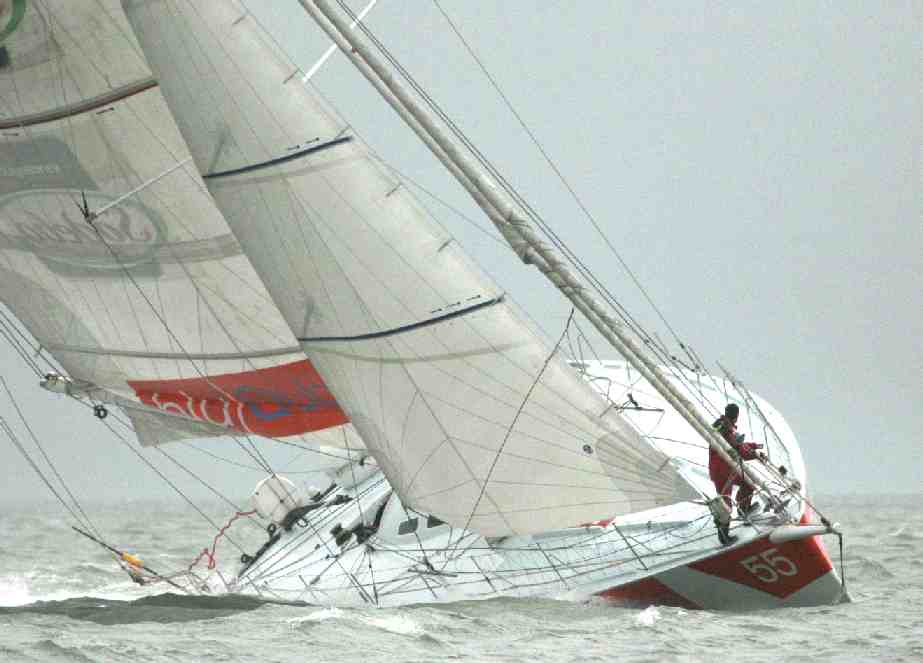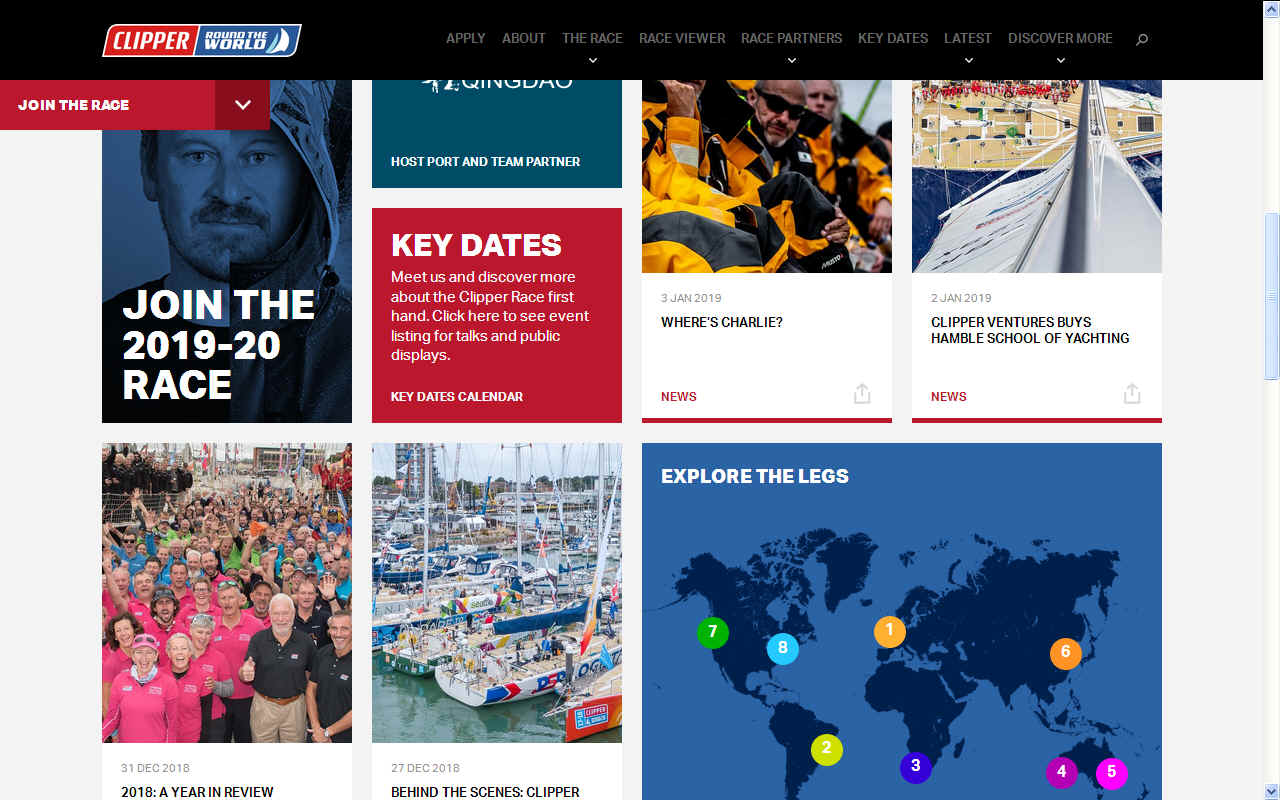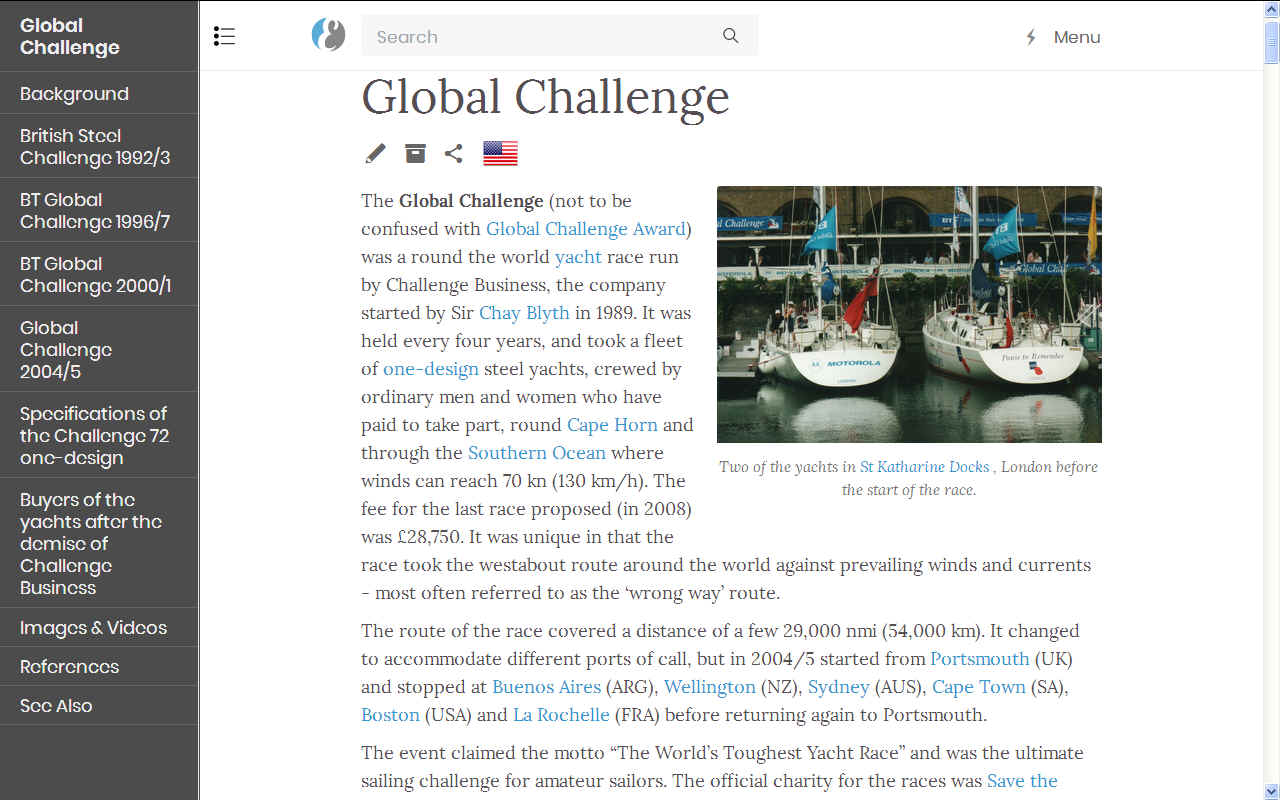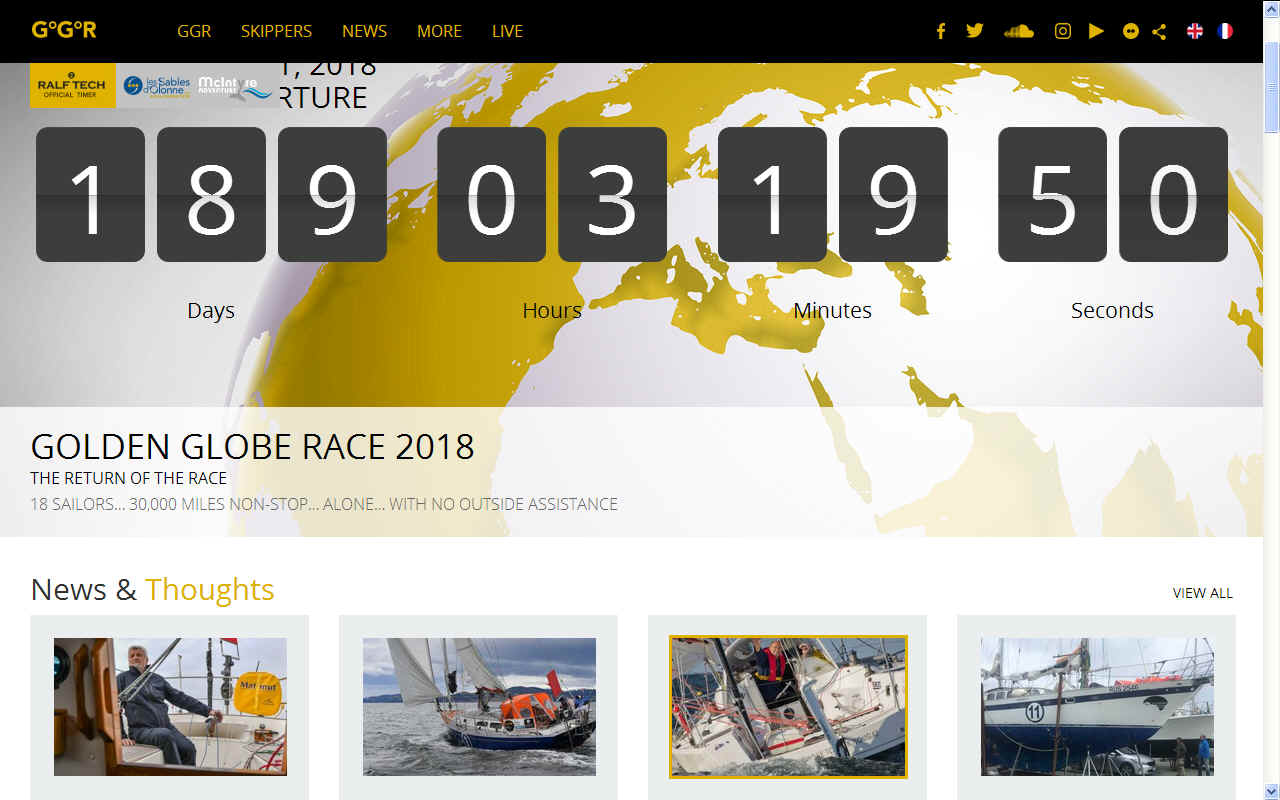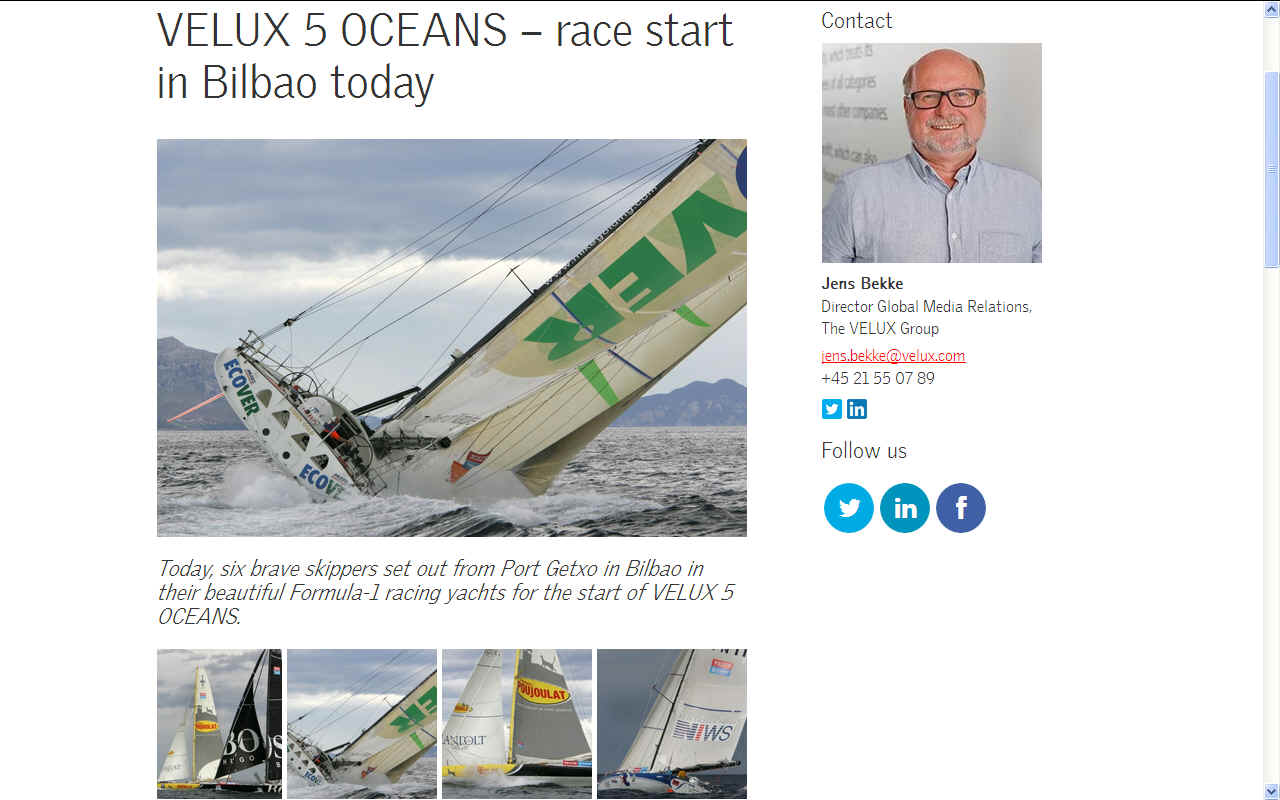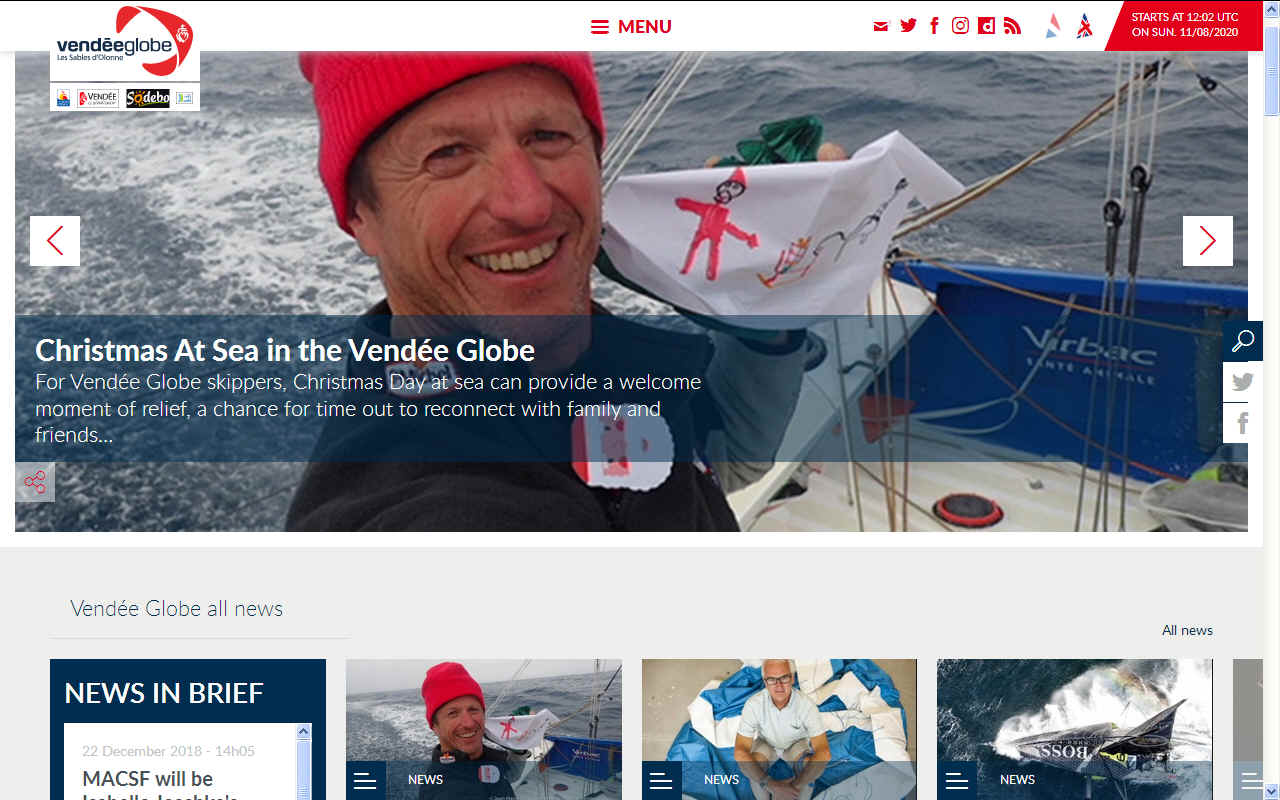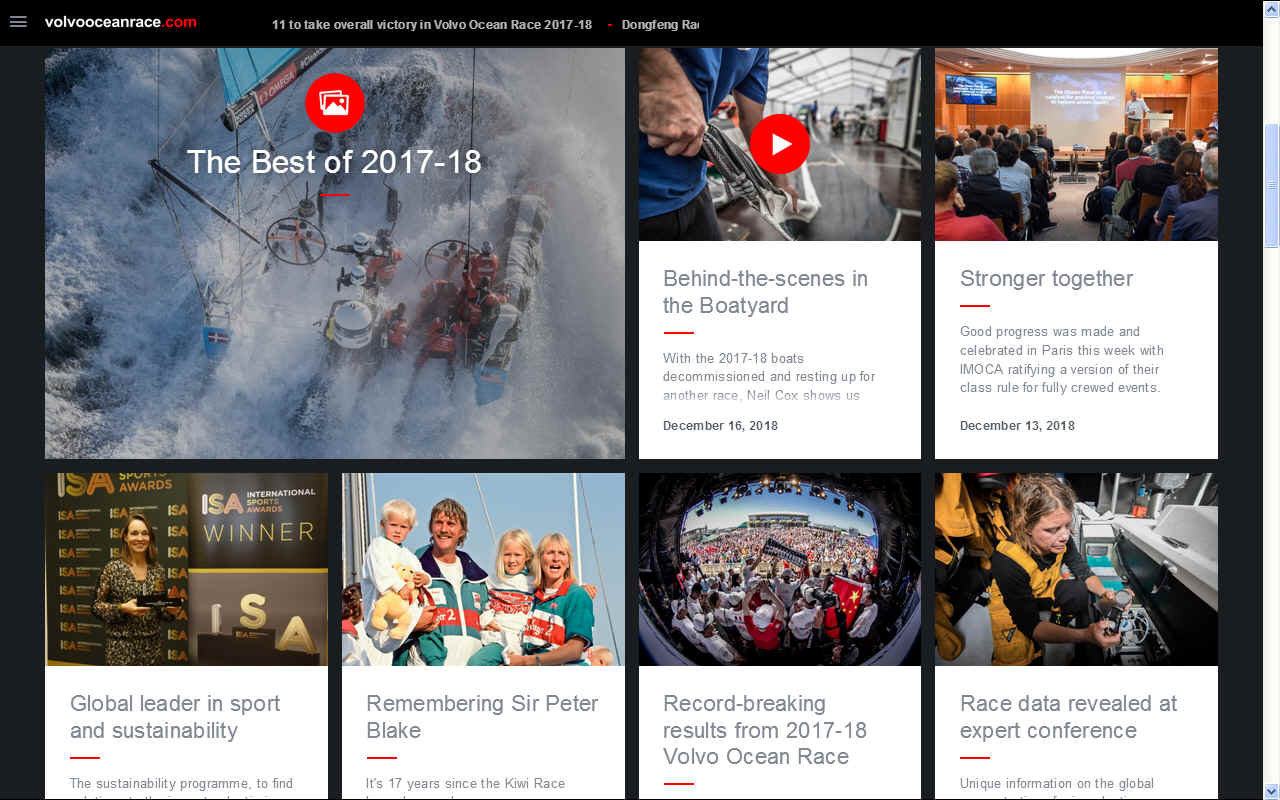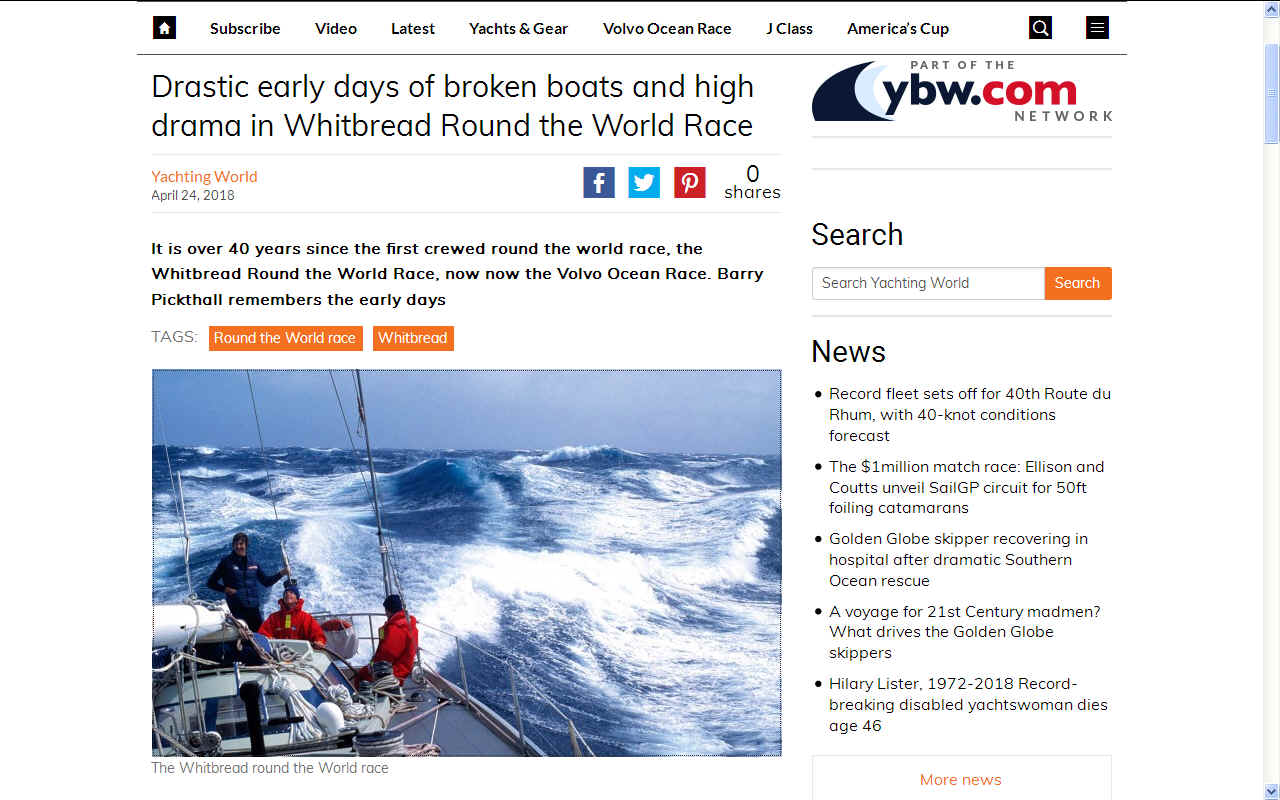|
THE GLOBAL CHALLENGE
|
||||||||||||||||||||||||||||||||||||||||||||||||||||||||||||||||||||||||||||||||||||||||||||||||||||||||||||||||||||||||||||||||||||||||||||||||||||||||||||||||||||||||||||||||||||||||||||||||||||||||||||||||||||||||||||||||||||||||||||||||||||||||||||||||||||||||||||||||||||||||||||||||||||||||||||
|
In Autumn 2008, 12 identical 72ft ocean racing yachts were to sail from the UK, ready not just to survive those conditions, but to race through them. Each yacht will be crewed by 17 ordinary men and women led by a professional skipper. Most wanted to be in the team that won the Princess Royal Trophy but now this seems unlikely due to financial circumstances of the organising company.
It was a tough race because they raced ‘the wrong way’ around the world - against the prevailing winds and currents. Conditions ranging from the calms and energy-sapping heat of the doldrums to the icebergs, storms and monumental seas of the southern oceans.
Global Challenge was more than just a yacht race. It brought together the business community, a major charity – Save the Children, the media and tens of thousands of supporters as well as the crews. Over 120 organisations participate in the event through sponsorships and partnerships. Spectators from around the world visit the ports of call and track the event on the race website and through coverage in the world's media. During the race the Global Challenge 2004/05 website had 37.5 million page views.
The design principles for the 72ft Global Challenge race fleet were carefully chosen to ensure they are safe, seaworthy and with high performance in a wide variety of conditions. The yachts, built during 1999/2000, proved their worth having successfully completed two circumnavigations of the world (competing in the BT Global Challenge 2000/01 and the Global Challenge 2004/05) plus numerous offshore races since then.
They are optimised for heavy upwind sailing but perform well in the wide variety of conditions they will face while racing around the world.
The yachts undergo an extensive refurbishment programme in preparation for the Global Challenge 2008/09 during which the yachts return to their "one-design" status with new masts, sails and rigging. Every single piece of equipment is checked, serviced or replaced in preparation for the World's Toughest Yacht Race. In 2004, this refurbishment cost £3.8m.
White Ocean Racing are seeking sponsorship for the remaining 2007 season for this Open 60 racing yacht and Steve White
The Global Challenge is a round the world yacht race run by Challenge Business, the company started by Sir Chay Blyth in 1989. Held every four years, it takes a fleet of one-design (or matching) steel yachts, crewed by ordinary men and women who have paid to take part, round Cape Horn and through the Southern Ocean where winds can reach 70 knots. The fee for the next race in 2008 was £28,750. It is unique in that it takes the westabout route around the world against prevailing winds and currents - often referred to as the ‘wrong way’ route.
The route of the race covers a distance of some 29,000 nautical miles (54,000km). It has changed to accommodate different ports of call, but in 2004/5 started from Portsmouth (UK) and stopped at Buenos Aires (ARG), Wellington (NZ), Sydney (AUS), Cape Town (SA), Boston (USA) and La Rochelle (FRA) before returning again to Portsmouth.
The event claims the motto “The World’s Toughest Race” and is the ultimate sailing adventure for amateur sailors.
The official charity for the races is Save the Children and the race patron is HRH The Princess Royal.
After failing to secure a title sponsor, the company went into administration on 9th October 2006 placing the future of the race in doubt.
Background
The seeds of the race were sown in Sir Chay Blyth’s previous sailing exploits. In 1970/71 he became the first person to sail alone round the world westabout in the yacht British Steel. The practicality of training people who had never sailed before was demonstrated during the 1973/74 Whitbread Race, when Blyth had raced Great Britain II with a crew from the Parachute Regiment. Subsequently he ran charters for paying crew.
The design philosophy for the identical yachts used on the Global Challenge races was forged by Sir Chay Blyth’s longtime associate Andrew Roberts. It was his idea to start from the largest top-action production winch available, which would in turn dictate sail area, displacement and size. He also oversaw the build of the two fleets of steel cutters used in the four races to date to designs by David Thomas and Thanos Condylis (Challenge 67) and Rob Humphreys (Challenge 72).
British Steel Challenge 1992/3
The first race started from Southampton in September 1992 with 10 identical 67ft boats sailed by a skipper and 13 crew. There were a number of serious rigging screw failures in the Southern Ocean and British Steel II was dismasted in mid-Southern Ocean, but managed to motorsail safely to Hobart under jury rig. She was re-rigged in time to rejoin the race for the next leg to Cape Town.
The winner of the first race was John Chittenden and crew in Nuclear Electric . Chittenden went on to win the 2001 Yachtsman of the Year Award.
BT Global Challenge 1996/7
An expanded fleet of 14 Challenge 67 yachts set out from Southampton in driving rain and gales. Again rigging problems struck in the Southern Ocean and Concert was dismasted. Skipper Chris Tibbs and crew made a jury rig and motorsailed to Wellington, New Zealand. Concert was re-rigged in time to start leg 3 from Wellington to Sydney and was 2nd on the Sydney to Cape Town leg. Yacht Pause to Remember, skippered by Tom O'Connor, suffered a snapped boom half way between Sydney and Cape Town. There seemed no choice but to fly their trysail until crewmembers Graham Phelp and Matthew Reeves took on the challenge of trying to repair it by using a cut out section as a splint. Two days later a shortened boom emerged from below decks and was successfully attached to the mast. Three weeks later and having suffered several storms with wind speeds in excess of 50 knots, Pause to Remember sailed into Cape Town, with boom still intact.
This race featured an extra leg to Boston and a crew of disabled men and women took part on “Time & Tide”, the first to sail round the world.
Mike Golding dominated, winning five out of six legs in Group 4 with Andy Hindley winning the remaining leg in Save the Children . Three skippers had graduated from being crew volunteers four years earlier: Andy Hindley; Mark Lodge; and Simon Walker.
BT Global Challenge 2000/1
On 10 September, a new fleet of 72ft steel cutters made their debut in this race. The winner, Conrad Humphreys and crew on LG Flatron , won four of the six legs.
Quadstone collided heavily in a port and starboard incident with Save the Children in Wellington, NZ, and Quadstone retired from this leg. Skipper Alex Philips later resigned. Both boats had to be extensively repaired in New Zealand.
For the first time the race was scored on points, with equal points for each leg, though combined elapsed times are shown here for comparison.
* These teams did not finish all legs, a requirement for a position in the overall standings, but their positions are shown without displacing any other team
Global Challenge 2004/5
The same fleet of 72ft yachts sailed again in the 2004 race, and the winner was the Australian skipper Andy Forbes and his crew on BG SPIRIT , who won three of the seven legs. Once again, although the overall safety record of the race was very good, medical emergencies did unfold, most notably onboard yachts 'Imagine It. Done.', 'Stelmar', and 'Save The Children'. In the case of 'Imagine It. Done.', only an extraordinary combined effort of several yachts within the fleet, the doctor onboard (Dr Roche), and the efforts of the Westpac Rescue team saved the life of John Masters.
* Retired from leg 2 from Buenos Aires to Wellington (NZ) after a medical emergency on board.
Specifications of the Challenge 72 one-design
The current 12-strong race fleet of Challenge 72-footers was developed from the Challenge 67s and was specifically designed to be strong, safe and seaworthy in even the worst conditions and to be self-sufficient for long periods at sea, with enough fuel and water to take their crews safely to a distant port. The yachts were also designed to be relatively easy to sail and handled by crews who are not professional.
Designed by Rob Humphreys, the identical 72-foot steel ocean racing yachts were built by Devonport Yachts in the UK by a new method using a unique flat-pack yacht assembly kit of precision cut laser steel panels.
Ten of the twelve yachts were built by Devonport, UK, the other two by Kim's Yacht Company in China.
LINKS and REFERENCE
|
||||||||||||||||||||||||||||||||||||||||||||||||||||||||||||||||||||||||||||||||||||||||||||||||||||||||||||||||||||||||||||||||||||||||||||||||||||||||||||||||||||||||||||||||||||||||||||||||||||||||||||||||||||||||||||||||||||||||||||||||||||||||||||||||||||||||||||||||||||||||||||||||||||||||||||
|
This website is Copyright © 1999 & 2019. All rights reserved. All other trademarks are hereby acknowledged. Max Energy Limited is an educational charity.
|
